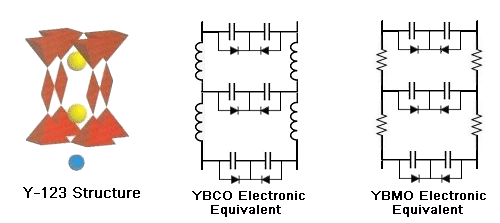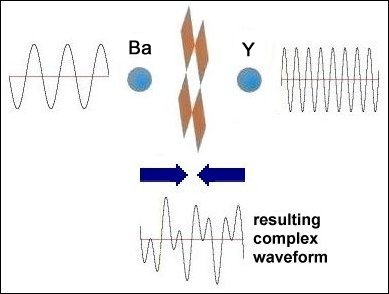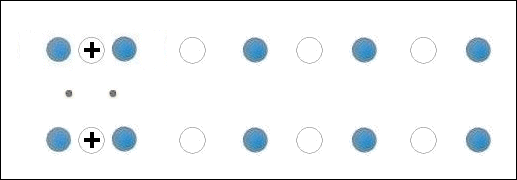



In 2016 Superconductors.ORG announced that magnesium had been successfully substituted into the copper atomic sites of several HT superconductors: Y-123 (YBCO), SrCaCu2O4 and CdCaCu2O4. In testing, the YBMO Meissner transitions were all found to be within one degree of their copper progenitor's transitions. (The Meissner effect is strong diamagnetism that is a byproduct of superconductivity.) However, recent resistance tests on the YBMO analog of YBCO, found it to be an electrical insulator — not a superconductor.
Though there is a phenomenon known as a pseudo-Meissner effect, it is usually only found in exotic materials like Weyl superconductors. None of these 3 compounds was a Weyl type. So something else must be going on. The classic Meissner effect occurs when surface currents induced by an external magnetic field exactly mirror that field and expell it from the superconductor's interior. YBMO showed no conductivity and, therefore, has no surface currents. Yet the strength of the diamagnetic transition was nearly as strong as that of YBCO (see plots at page top).

In order to better understand the mechanism of superconductivity, an electrical equivalent of YBCO and YBMO was created (above). Since copper-oxide is anti-ferromagnetic (AF) in the undoped state, an inductive coil  is shown. And since all oxides store an electrical charge, capacitors
is shown. And since all oxides store an electrical charge, capacitors  are used to represent barium-oxide and yttrium-oxide.
For the YBMO equivalent resistors
are used to represent barium-oxide and yttrium-oxide.
For the YBMO equivalent resistors  are substituted for inductors, since
magnesium-oxide is not AF. There are also diodes
are substituted for inductors, since
magnesium-oxide is not AF. There are also diodes  indicating electron flow from the anion layers to the cation layers.
indicating electron flow from the anion layers to the cation layers.

In order to initiate the pairing of electrons, thermally-powered lattice vibrations begin compressing the oxygen ions. Maximum compression happens when the atomic sites are collinear along the C axis (vertical on Y-123 graphic). Planar weight disparity has been found to correlate directly with transition temperature. In these materials Y-123 has barium in opposition to yttrium across an oxygen site to accomplish this (see above). Once the oxygen site begins exchanging electrons, the AF CuO2 sites start interacting magnetically, as AF gives way to ferromagnetism.
In electronics the coupling of an inductor with a capacitor is called a "tank circuit". The reactive components in a tank circuit transfer charge back and forth. And at a resonant frequency, this energy transfer reaches maximum. However, in YBMO there is no ferromagnetism to resonate with the adjacent capacitance. So the energy is lost at the resistor. The energy gap necessary to break up a Cooper-pair comes from the same thermal source that initiated the electron pairing: Random vibrations that disrupt the synchronized movement of electron pairs — but not before there is an instant of coupling. This brief moment, happening in millions of unit cells simultaneously, creates sufficiently strong diamagnetism to appear as a Meissner effect (see below animations).




Stoichiometric ratios of the below chemicals were used in the synthesis of these materials:
Y2O3 99.99% (Alfa Aesar) The chemical precursors were pelletized at 60,000 PSI. The pellet was first calcined at 760C for one hour. Then it was sintered for 8 hours at 880C and annealed for 10+ hours at 500C in flowing O2. The magnetometer employed twin Honeywell SS94A1F Hall-effect sensors with a tandem sensitivity of 50 mv/Gauss, operating within an ambient magnetic field of 550 - 600 milliGauss. Testing temperatures were determined using an Omega type "T" thermocouple and precision OP77 DC amplifier.
RESEARCH NOTES: These materials can be strongly hygroscopic. All tests should be performed immediately after annealing. Typically copper-oxide superconductors turn charcoal black after being sintered. The color after sintering of the magnesium superconductors was a bright white.
E. Joe Eck
Patent Pending US 62/391,842
© 2025 Superconductors.ORG
All rights reserved
1. The YBCO test pellet was obtained from Colorado Superconductor, Fort Collins, CO
2. Although the oxygen content is believed to be the same with Mg as it was with Cu,
Ox denotes that this will need to be determined for certain through x-ray diffraction.
 BACK to "News" page at Superconductors.ORG
BACK to "News" page at Superconductors.ORG